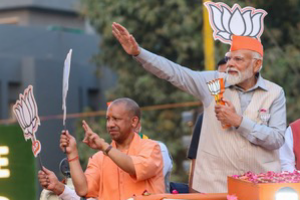There is a fine line between culture and politics, and they sometimes morph into each other seamlessly. Artistic endeavours in Pakistan often contain political content. The reason is the political uncertainty that seems to be a constant in the country’s history.
The two parallel solo exhibitions that took place at Karachi’s Canvas Gallery recently have cultural concerns at their core. Raheela Abro and Affan Baghpati’s works take inspiration from South Asian folklore and design respectively — two very distinct subjects that fall under the purview of culture.
Abro, a member of faculty at the University of Karachi and the Indus Valley School of Art and Architecture, had on display 13 paintings, all subjective and nuanced, with a tinge of surrealism.
Her oeuvre is an ode to Watayo Faqir, a 10th century Muslim convert. Watayo’s thought-provoking words and satirical utterances have taken the shape of folklore that serve as life lessons to children of present-day Sindh.
Abro has attempted to express Watayo’s meaningful maxims through her paintings. Animals and insects — dogs, cats, owls and butterflies — are a common feature in her paintings, found mostly surrounded by “white” light, representative of God’s benevolence. This “white” is evident in almost all of her paintings.
One of Abro’s paintings titled White 6 is a small horizontal piece, divided into two. On the right of the piece is painted an ornate frame with filigree borders around blank white space. Depicted on the left is a painting within the painting of an archaic gold urn with grapes adorning its surface. Adding a surreal touch to the piece, a single larger-than-life grape seems to have exited the urn’s decorative surface and lies in front of it.
Abro’s work has a touch of post-modernist flatness; the images are representational yet her work is not realistic. Instead it has a child-like finish, lending her oeuvre a feel of the fourth dimension. This and the fact that, even though her medium is oil and acrylic, her style is distinctly miniaturesque, a deliberate act on the part of Abro who is formally trained in miniature painting.
Baghpati’s solo exhibition, titled “Once upon a land”, that opened in tandem with Abro’s “White”, has on display a multitude of objects, both free-standing and framed. The artist’s sculptural pieces celebrate an era rapidly disappearing in this age of mass production, fast food and fast fashion, through objects he has picked up from local markets across the country. His chosen objects — be it a surmedanior an azarbandani— serve as an ode to yesteryear design, material and cultural sensibilities.
Unfortunately, these handcrafted objects can be bought for minute sums of money or are melted down to obtain their composing raw material i.e. metal. In pieces such as Camel on Pipe, and Bullock on Sindoordani, Baghpati has made minor but excessively delicate and detailed ornamental alterations to the objects by carving out a complete animal figure that may be less than two centimetres in size and replaced it, on, or around the body of the object.
These pieces are framed in decorative white frames that form part of the artwork, denoting a feel of preciousness to the object placed within. Besides these intricate pieces, Baghpati has also deconstructed some old-world metal objects, adding and subtracting bits and bobs from various articles to create familiar small-scale sculptural pieces.
These add humour to his practice. This is exemplified by the piece titled Tea Strainer: Toilet Seat. As the name suggests, the artist has pulled apart a metal tea strainer and reassembled it in the shape of a toilet seat.
Dawn/ANN











